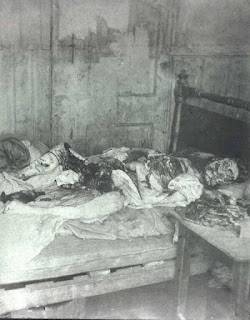The Last Victim Of Jack The Ripper
The Last Victim Of Jack The Ripper
The final victim of the infamous serial killer Jack the Ripper, Mary Jane Kelly was found murdered and mutilated on Nov. 9, 1888. When a rent collector entered the room she was staying in, he found Kelly on her bed with various body parts and organs cut out and placed beside her corpse.
Kelly was far more mutilated than any of the other four victims that Jack the Ripper had killed in the Whitechapel and Spitalfields districts of London in the preceding months. Concealed behind Kelly's closed door, the Ripper took his time and spent nearly two hours carving up her body in various ways before sneaking away, never to be caught or even heard from again.
Mary Jane Kelly (c. 1863 – 9 November 1888), also known as Marie Jeanette Kelly, Fair Emma, Ginger, Dark Mary and Black Mary, is widely believed to have been the final victim of the notorious unidentified serial killer Jack the Ripper, who murdered at least five women in the Whitechapel and Spitalfields districts of London from late August to early November 1888. At the time of Kelly's death, she was approximately 25 years old, working as a prostitute and living in relative poverty.
Unlike the other four canonical Ripper victims—each of whom had been murdered outdoors and whose mutilations could have been committed within minutes—Kelly was murdered within the sparsely furnished single room she rented at 13 Miller's Court, affording her murderer an extensive period of time to eviscerate and mutilate her body. Kelly's body was by far the most extensively mutilated of the canonical victims, with her mutilations taking her murderer approximately two hours to perform.
Elizabeth Prater, who resided in the room directly above Kelly's and who had been awoken by her kitten walking over her neck, and Sarah Lewis, who had slept at number 2 Miller's Court on 8–9 November, both reported hearing a faint cry of "Murder!" between 3:30 a.m. and 4 a.m., but did not react because they reported that it was common to hear such cries in the East End. Lewis described this cry as "only one scream. I took no notice of it". She claimed not to have slept and to have heard people moving in and out of the court throughout the night. Prater did leave her room at approximately 5:30 a.m., to walk to the Ten Bells pub for a drink of rum. She saw nothing suspicious.
On the morning of 9 November 1888, the day of the annual Lord Mayor's Day celebrations, Kelly's landlord, John McCarthy, sent his assistant, ex-soldier Thomas Bowyer, to collect the rent. Kelly was six weeks behind on her payments, owing 29 shillings. Shortly after 10:45 a.m., Bowyer knocked on her door but received no response. He then attempted to turn the handle, only to discover the door was locked. Bowyer then looked through the keyhole, but could not see anybody in the room. Pushing aside the clothing used to plug the broken windowpane and the muslin curtains which covered the windows, Bowyer peered inside the room—discovering Kelly's extensively mutilated corpse lying on the bed. She is believed to have died between three and nine hours before the discovery of her body.
Bowyer ran to report his discovery to McCarthy, who first verified his claims, then instructed Bowyer to inform the Commercial Street Police Station. Bowyer ran to the police station, stammering the words: "Another one. Jack the Ripper. Awful. [John] McCarthy sent me" to Inspector Walter Beck. Beck accompanied Bowyer to Miller's Court, and immediately requested the assistance of police surgeon George Bagster Phillips. He also gave orders preventing any individuals from entering or exiting the yard. Beck also arranged for news of the murder to be telegraphed to Scotland Yard, and requested the assistance of bloodhounds. The scene was attended by Superintendent Thomas Arnold and Inspector Edmund Reid from Whitechapel's H Division, as well as Frederick Abberline and Robert Anderson from Scotland Yard, who arrived at the crime scene between 11:30 a.m. and 1 p.m.
News of the discovery of another Ripper victim spread rapidly throughout the East End. Crowds estimated to number over 1,000 gathered at each end of Dorset Street, with many members of the public voicing their frustration and indignation at the news.
Arnold ordered the room broken into at 1:30 p.m. after the possibility of tracking the murderer from the room with bloodhounds was dismissed as impractical. A fire fierce enough to melt the solder between a kettle and its spout had burnt in the grate, apparently fuelled with women's clothing. Inspector Abberline thought Kelly's clothes were burnt by the murderer to provide light, as the room was otherwise only dimly lit by a single candle Kelly had purchased on 7 November.
After two official crime scene photographs had been taken, Kelly's body was taken from Miller's Court to the mortuary in Shoreditch, where her body was formally identified by Joseph Barnett, who was only able to recognise Kelly's body by "the ear and the eyes". John McCarthy also viewed the body at the mortuary and was also certain the deceased was Kelly.




Comments
Post a Comment